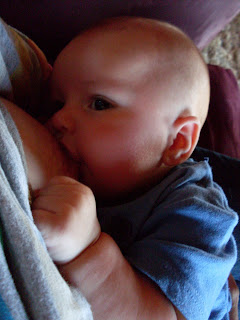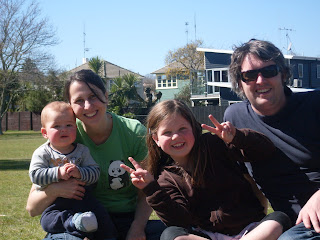Back in 2009 I became pregnant with my third child. My daughter, Laura, was seven at that time and my son, Luca, was eight months old. I was still breastfeeding Luca when I became pregnant and hoped that I could continue to breastfeed him for a long time to come (I'd breastfed Laura until she was three). I began journalling my experiences of breastfeeding whilst pregnant which, later, transitioned to a diary of my tandem feeding journey.
Originally these diary entries were published in the Waikato Home Birth Association's magazine, called 'B', and later they were published in Home Birth Aotearoa's magazine, 'Birthplace'. I had a lot of positive feedback from readers about these articles, so thought I'd start posting one per week on my blog in case others might enjoy them, and benefit from reading them, too.
 |
| Breastfeeding Luca at 4 months |
Pregnant and Breastfeeding
Gee, I never realised there were so many people out there ignorant of the concept ‘tandem breastfeeding’. I guess tandem breastfeeding has been such a common occurrence amongst the mothers I associate with that I had not realised what a little-known and poorly understood parenting choice it is amongst the general public. For those of you reading this who have not, yourselves, heard of tandem breastfeeding before, it is where a mother continues to breastfeed her toddler whilst breastfeeding her newborn (actually, it means breastfeeding more than one child, so it applies to breastfeeding twins or triplets too).
When my son, Luca, was eight months old I became pregnant again. I am now 17 weeks into my pregnancy. Although really excited to have become pregnant with my third child, I did feel anxious that it may mean Luca would wean much earlier than I would be comfortable with. Most pregnant women who are still breastfeeding have a large drop in their milk supply at about mid-pregnancy, and sometimes this leads to the toddler choosing to wean (or the mother choosing to wean her toddler because ‘dry’ feeding can be very painful). Also, the pregnancy hormones alter the taste of the milk and this too, can cause a toddler to wean even from very early on in the pregnancy.
I have decided to keep a diary of my experiences as a pregnant breastfeeding mother, and hopefully, one day, a tandem breastfeeding mother.
First 12 weeks of pregnancy
If my milk has changed flavour Luca certainly doesn’t seem to mind the taste. He is still the eager feeder he has always been. In fact, I haven’t noticed any changes in our breastfeeding relationship at all so far, the pregnancy hasn’t even caused me any breast or nipple tenderness. This certainly feels like a positive start. Furthermore, I haven’t been suffering much morning sickness at all. Nothing like when I was pregnant during my first trimester with both Laura and Luca. I’ve started reading the book ‘Adventures in Tandem Nursing’ by Hilary Flower which does say that for some women pregnancy lessens morning sickness and for others it makes it worse. Guess I’ve got lucky!
One big change has been my appetite. When breastfeeding, I eat loads. When pregnant, I eat loads. When pregnant and breastfeeding, I eat mountains! My stomach is a bottomless pit. I even put Mark (my big hubby) to shame at the dinner table (I think he’s quite shocked at how much food I can put away!). And if I don’t snack frequently throughout the day my blood sugar seems to drop super fast which is the only time I ever really feel queasy.
It’s strange, but because I’m not experiencing hardly any morning sickness and because I haven’t experienced any breast tenderness, I’m finding it hard to believe I am really pregnant. In saying that, I can no longer fit most of the clothes that I have only recently started fitting again since birthing Luca, but that might just be because I am eating like a hippopotamus. Depressing! When my midwife came to visit at 12 weeks I even asked her to have a listen for the baby’s heart beat with the Doppler (which I typically wouldn’t bother with). I just felt I wanted some convincing that there really was another baby on the way. And, of course, there was the reassuring little ba-dum-ba-dum-ba-dum-ba-dum of my baby’s heart. Okay, so it really is happening.
12 – 15 weeks
A number of my friends have seemed quite shocked that I am still breastfeeding Luca even though I am pregnant. They hadn’t thought it possible to get pregnant whilst breastfeeding. Interestingly, when I was breastfeeding Laura, I didn’t start getting my period again until she was 19 months old, but with Luca, he was just 5 months old. This was probably because Luca had a couple of long stretches of sleep (6 or 7 hours) at night when he was a newborn. Unfortunately, gone are those days – Luca hasn’t tended to sleep more than 2 hours (3 hours max) at a stretch for months. I think Laura was about 4 years old before she had her first 6 hour stretch of sleep!
My massive hunger hasn’t abated in the slightest. I now do not leave the house without a source of food. The ‘pick and mix’ section at the supermarket has become my feasting saviour. I always have a ready supply of dried fruits and nuts. It feels very reassuring having some of these stored in my car glove box and hand bag! Certainly beats the nausea and faintness I quickly feel if I let my blood sugar drop.
Luca is still a terrible sleeper and I am starting to feel anxious that this may not resolve itself before the next baby comes. Since he was four months old he has woken hourly through most of the night, most nights. We decided to employ a wonderful baby sleep ‘specialist’ to help us sort out his sleep (one who does not advocate leaving a baby to cry on it’s own as a means of learning to sleep). So far progress has been slow, but I do feel confident that we will get there. At the very least, Luca has learnt that he does not need a breastfeed to get back off to sleep every time he wakes at night. He is now down to just two night feeds. I intend to completely night wean him before the next baby arrives (couldn’t imagine trying to breastfeed two babies through the night), so this is a good start.
Mark’s nana has given me my first wee taste of negativity towards my intention to tandem feed. She’s a lovely woman and was certainly very sensitive and sweet in how she broached the ‘issue’ with me. Her concern is that my health will suffer too much if I am feeding two littlies, especially because my babies never seem to allow me much sleep. I felt quite defensive, but I suppose she may have raised an important point – just how will my body cope? I am already feeling rather exhausted.
Another ‘downer’ has been the discussions I have been having with women who have tandem fed or were keen to but unable. The stories have tended to be more negative than positive which I have found quite disheartening. It seems that for most of the women I have spoken to, the physical pain of breastfeeding during pregnancy has been a massive (sometimes insurmountable) hurdle for them. I haven’t experienced any such pain yet, but they tell me that it starts about mid pregnancy for most. Time will tell I guess.
15 – 17 weeks
Beginneth the pain of breastfeeding whilst pregnant! Over the past couple of weeks it has become increasingly painful when I initially latch Luca at the breast. Thankfully the pain is only brief and, at this stage, quite bearable. It feels like it did when Luca was a newborn and my nipples were recovering from a bit of surface grazing. My milk supply must have decreased a bit as I no longer need to wear breast pads for leaking – perhaps this is why the tender latching has started.
Luca started to request very frequent feeding a week ago. I thought he was just going through a particularly clingy phase but it turns out he was keen to kick into the solids in a big way (perhaps due to the decreased milk supply). He has never been into solids much at all until this point and it is quite an adjustment for me having to prepare and feed him lots of food. Breastfeeding is so much more convenient and easy!
Nights are still rather rough. The plan is soon to night wean Luca completely in the hope that this will lead to longer stretches of sleep. I have to psych myself up for it though because I know it is going to involve less sleep and more tears (for both Luca and myself!) before it helps. Wish us luck!
I have been attending monthly Le Leche League meetings and they are fantastic – such an awesome source of information and support. I figure such help may well become essential if breastfeeding during my pregnancy becomes a big challenge.
 |
| Early in my pregnancy. Luca (10 mths), me, Laura (7yrs) and Mark |

